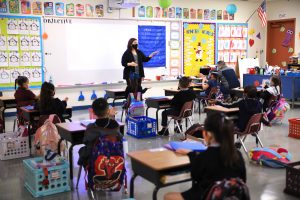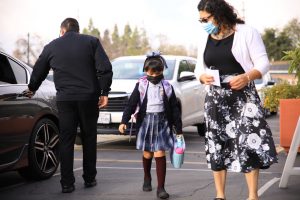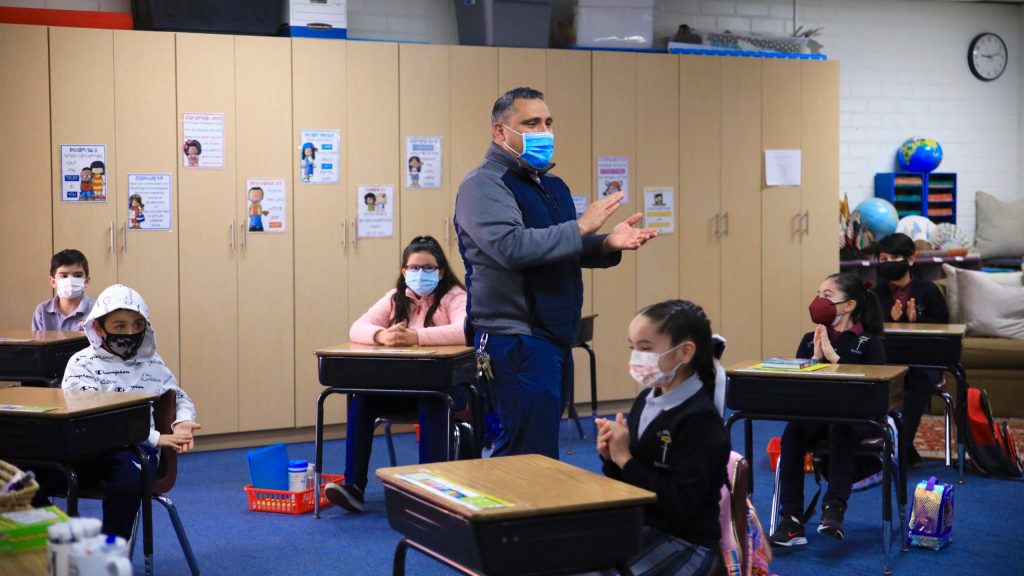After emptying out of their families’ cars into the parking lot of St. Bernard School in Bellflower on March 3, the steady stream of students from kindergarten through sixth grade were met with a banner that included large red block letters: “WE’VE MISSED YOU!”
Aaron De Loera, the principal of the parochial school near the 91 and 605 freeways, described the sight of most of his school’s 200 students returning to classrooms after nearly a full year of distance learning as “true joy.”
“In terms of being ready, we have to abide by the rules, but once that was done, we have to look at the real needs of the students and let God guide us with that mission of the Catholic schools,” said De Loera.

Catholic school principals like De Loera around the Archdiocese of Los Angeles have had to weigh a number of factors in deciding when — and how — to return to in-class instruction since the first partial reopenings last fall. School officials expect that as of March 15, 70% of schools in the archdiocese will have welcomed back TK-6 students back to the classroom. Another 18% of schools have a reopening date set after March 15, and the remaining 12% are in the process of setting a reopening date, according to figures from the archdiocese's Department of Catholic Schools.
Last week, after months of patient waiting, it was St. Bernard’s turn.
“The teachers were prepared, the school was prepared, and we had a good gauge of the students’ need for this — not just in physical or psyche terms, but in spiritual terms,” explained De Loera. “The students need to hear about Christ on a daily basis to help them make sense of everything and feel taken care of, safe and loved. With the parents’ help, we instill that faith in the children.”
Overseeing a school with demographic of about 65 percent Hispanic families (the rest are split fairly evenly among White, African American, Asian and multi-racial), De Loera said the community has been “relatively safe” from COVID outbreaks, another key to their reopening plan.
Regular interactions with parents and the increase of teachers receiving COVID-19 vaccination shots gave De Loera more confidence going forward with reopening.

He estimates about 85 percent of students eligible to return are doing so and will be keeping with all CDC guidelines. The fact some choose to stay with remote or a hybrid model “is perfectly fine,” he added.
The next step is bringing back 7th and 8th graders, the latter of whom are preparing for the transition to high school. St. Bernard is a feeder to area Catholic high schools including Bellflower’s St. John Bosco, Lakewood’s St. Joseph’s, and Downey’s St. Pius X-St. Matthias Academy.
“The middle schoolers are a tough enough age group to be in, but they’re doing their best online, we have a great team dedicated to their well-being, and one way or another we will have the eighth-grade graduation and all that pomp and circumstance for them,” said De Loera.

This week, an Archdiocese of Los Angeles school-specific vaccination clinic at Loyola Marymount University that has offered 400 Moderna shots accelerated classroom re-openings, said Paul Escala, senior director and superintendent of LA’s Catholic schools.
“It feels like we've come full circle,” said Escala. “A year ago at this time, we’re trying to figure out how we’re going to proceed with continuing learning as COVID arrived, and now we’re in a position that many of us thought months ago couldn’t happen.”
At the present rate, students from seventh grade through high school could return to classrooms in a matter of weeks, depending on County public health rules, Escala anticipates. Meanwhile, LA’s public school district reached a tentative agreement with the local teachers union to begin reopening schools for in-person instruction as soon as next month.
Still, Escala says parents, teachers and students should be reasonable with their expectations, and notes that no readjustment will be without challenges.

“We still need to be smart about what this all means. Human beings aren’t just light-switches that can be turned on and off,” said Escala, who started this superintendent role in the summer of 2019.
“Decisions to return and expectations of things going back to normal don’t just happen. There can be a lot of emotional and psychological elements that are necessary to monitor from having been away for so long.”
Escala, who said he received his first Pfizer vaccination shot a week ago, said it isn’t realistic to expect 100 percent of students to return even with tier colors moving.
“If people need more time, that’s OK. The goal is working back from the upcoming Easter break to wait and see how the kids are doing in person. Overall, we’re in a place of transitioning back and the focus will be on doing it safely.”
De Loera agreed.
“There can be a lot of gray area here, but if we keep working with the supervisors and the superintendents, at some point we’re counting on the will of God helping us,” De Loera said. “The mission of the Catholic church is our primary guide. We’re in good hands with God.”

